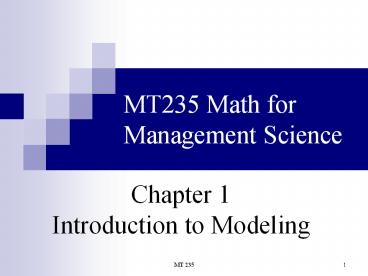MT235 Math for Management Science - PowerPoint PPT Presentation
1 / 14
Title:
MT235 Math for Management Science
Description:
Mathematical models - symbols are used to ... The Modeling Process ... The next step in the modeling process involves simplifying and abstracting from ... – PowerPoint PPT presentation
Number of Views:89
Avg rating:3.0/5.0
Title: MT235 Math for Management Science
1
MT235 Math for Management Science
Chapter 1Introduction to Modeling
2
Decision Analysis
- Decision Science, Management Science, Operations
Research, Operational Research - Applying the methods of science to management
decision making - Methods of Science - logic, mathematics,
computers and the use of models
3
A Modeling Approach to Decision Making
- Mental model - picturing in your minds eye
- Verbal model written or oral representation
- Visual model - blueprints, schematics, maps
- Physical models - scale models and prototypes
- Mathematical models - symbols are used to
represent decision variables which approximate a
real system or decision problem
4
A Modeling Approach to Decision Making
- Models are abstractions of reality
- They seek out and represent the major effects in
a system - Simplicity is their advantage
- Simplicity is their weakness
If a model doesnt faithfully represent reality
change the model.
5
Benefits of Models
- Less costly to analyze than real system or
problem - Outcomes be analyzed more rapidly
- Provide insight about real problem or system
- Facilitate what if and whats best analysis
6
The Modeling Process
- The process of building a model begins with an
understanding of the real world system.
Management must be able to answer questions such
as
7
The Modeling Process
- What drives the system under consideration? What
is the goal? - What are the key factors which predict the
behavior of the system? - What problems are relevant to management?
- What are the appropriate measures of success?
- What can a manager change?
- What things are givens (for the current
scenario)?
8
The Modeling Process
- The next step in the modeling process involves
simplifying and abstracting from the real world
system. This model formulation step is
exceptionally important.
9
The Modeling Process
- If the model is too simple the results may be
unrealistic. - If the model is too complex, it may be difficult
if not impossible to solve.
10
The Modeling Process
- Once a model is formulated an appropriate
solution methodology must be identified. - This will be based on the relationships embodied
in the model. - Data must also be collected to estimate the
parameters of the model. - Some information will be precise.
- The values of some parameters might have to be
guesses.
11
The Modeling Process
- Just because a solution might be available at
this point does not mean that the managerial
questions have been answered. These solutions
must be interpreted. - Interpretation may be thought of as a reversal of
the formulation step.
12
The Modeling Process
- Formulation requires that the broad description
of the real world system be narrowed and
abstracted. - Interpretation requires that the narrow meaning
of the solution be broadened and applied to the
actual situation. - Thus the modeling process is an iterative one
13
Steps to Develop a Valid Model 1 of 2
- Determine the Goal what is being maximized or
minimized. - State the objective To determine. In order to
(meet the goal). - The goal involves those things over which the
manager has control. - The things enumerated in the statement of the
objective become the objective variables
14
Steps to Develop a Valid Model 2 of 2
- Determine the coefficients of the objective
variables. - The units must match the units in which the goal
is measured. - Identify the constraints.
- These values control the value of the decision
variables - These values are fixed for the given problem
the manager cannot change them in the given
scenario. - Write the constraint equations (inequalities).
- Each constraint is written in terms of each
objective variable. - The coefficient of some obj. vars. may be zero
(indicating that it has no effect on the
constraint.































